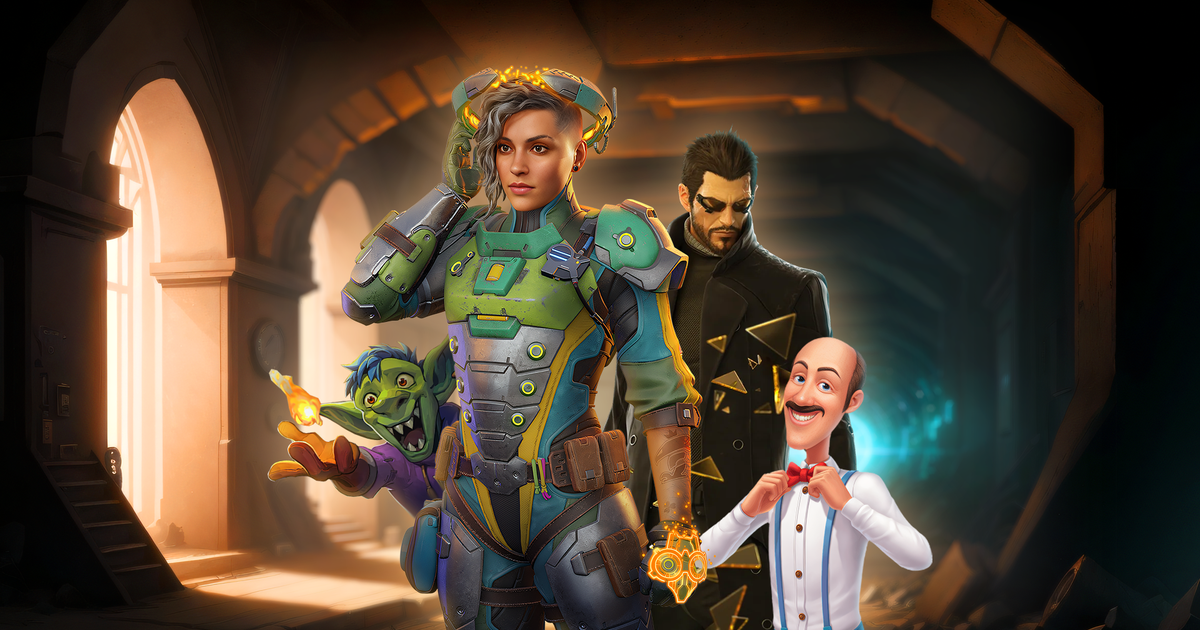- Signposted
- Posts
- Signposted #18
Signposted #18
Featuring A Game Design Roundtable, Disney Magic Kingdoms, The Division, & the Best of Game Design

Currently playing Hades 2.
Hey Designer,
Welcome to long awaited issue #18 of Signposted!
We have a MASSIVE issue this time around.
The SF Game Design Blog Archive is back with a look at how the Division’s Darkness Zone relates to the prisoner’s dilemma
The SF Game Design Blog Archive has a bonus issue with a look at Disney Magic Kingdoms’ economy
Carousel Game Design Concepts: Camera Angles
In the best of series, we’ve got some amazing pieces:
We’re taking a look at the Layers of Motivation for players
The Signposted community has spoken and wants to discuss Building game worlds with creative lifehacks from the field of writing
The highly recommended Game craft Enemy Combat Design series
The Design Doc is in with a video on Multi phases of a boss fight
In the realm f podcasts we have the Deconstructor of fun Squad Busters Definitive deconstruction
New additional resource: Level Design Portfolio review
If you enjoy Signposted please be sure to share it so more people can enjoy this content! 😁
We’ve got a hefty issue, let’s get into it!
Monthly Analysis and Updates
Design Chat Event
Recently members of the Signposted Community met up and dissected Dragon’s Dogma 2. We discussed everything from the core loop, to how balance changes affect the game, and more!
This time around Hades 2 won! We’ll play Hades 2 over the course of the next month then get together and analyze the good, the bad, and what we think we could improve on Friday 7/26 at noon Pacific time

And if you can’t make that one I’ll be hosting an Encore of the event the day after on Saturday 7/27 at 3 pm.

RSVP to one or both events in the discord:
The Best of Game Design
Game Design Roundtable - Journey into Systems Design
Recently I got together with three other designers to discuss systems design at each level (associate, mid level, senior, and lead).
We covered:
Our journeys into systems design
A day in the life of a systems designer
What systems design is like at different levels
And answered a few audience questions as well
Check out the recording below!
If you’re interested in comments during the presentation check it out here.
SF Game Design Archive
The SFGD Archive takes a fun look at some of my older blog posts and talks a little about my experience as a game designer (or more of trying to navigate the early days of my career). The third and fourth issues are available at the links below:
The Dark Zone Versus The Prisoner’s Dilemma
Originally Published March 24, 2016
Quick Takeaway:
The Dak Zone
The Dark Zone is a PvPvE area of the division which holds some of the best loot in the game
The player is tasked to go in, kill enemies, loot their bodies, then call in an extraction at specific points so they can use and keep the loot outside of the Dark Zone
This becomes complicated when there are other players in the area which can kill them and steal their loot
This gets further complicated when all players in the area are notified when a player goes rouge (kills another player) or calls in an extraction, both notifying the player’s location to all other players
How does the Prisoner’s Dilemma work
In a nutshell think of this scenario: there are two prisoners are being interrogated by the police
They are in different rooms and cannot communicate with one another
The police tell them if they cooperate they will get a reduced sentence but the other prisoner will get an increased sentence
The decisions look like this:
If prisoner A and B each betray the other, each of them will serve two years in prison
If prisoner A betrays B but B remains silent, A will be set free and B will serve three years in prison, and vice versa
If prisoner A and B both remain silent, both of them will serve only one year in prison on the lesser charge
The argument I make is that this logic can be applied to the Dark Zone when encountering other players as well
If player A betrays B, then A will get more loot and B will get nothing
If they both work together, they both get some loot but one player doesn’t get all the best loot
They can’t both betray one another since only one player can go rouge
This brings me to one of the larger issues with the Dark Zone
The incentive to go rouge is incredibly weak (this is the equivalent to betraying the other prisoner in our dilemma)
If I go rouge and kill a player I don’t know what kind of loot the other player has until they die. I’m painting a target on my back, potentially for no good reason
If I die while having gone rouge I lose my items, XP, and currency as well
The very high risk with likely low reward makes it better to ignore the ability to betray players all together, rather than reward the player for taking the risk
Tying it back to the prisoner’s dilemma, this is like telling both prisoners they’ll stay in jail an extra day if they betray the other prisoner, it’s not enough time to motivate them to betray them and risk their ire when they finally get out
A potential fix to this is to have the color of the player’s backpack match the color of the highest rarity item in it,(for example unique items might be purple) this messages to other players that this player is walking around with Legendary gear in his pack and makes it more worth the risk
Bonus Archive Article for this Issue: Disney Magic Kingdoms - Game Design Analysis
Originally posted on June 30th, 2016
Game Design Basics: Camera Angles
What is the relationship between camera angles and the level of intimacy the player is experiencing with the game?
In this carousel we’ll go over just that and dig a little deeper into why some camera angles are popular for specific genres.
Quick Takeaway:
Different camera angles are often used for specific experiences.
Why is that?
Experience intimacy - different styles of experience require more or less intimacy and immersion.
First Person
“What is happening on screen is happening to me”.
When you want to maximize the game’s intimacy and immersion typically you go first person.
Horror games particularly benefit from being in first person because it puts the player in the scary scenario.
Frequently seen in Horror games and shooters
First Person Examples
Amnesia, FNAF, Call of Duty
Third Person
“What’s happening on screen is happening to someone nearby”
When you want to be as intimate as possible, but still see what’s around you.
Often times there is a central character who is key to the story or character aesthetic customization and player expression is particularly important.
If you look at Helldivers 1 to 2 you notice the camera changes, the scale of what you’re fighting and explosions feel larger in 2 because of this.
Frequently seen in adventure games and action RPGs.
Third Person Examples
Zelda totk, kingdom hearts, helldivers
Top Down & Isometric
“I am far away from what’s going on, onscreen”
When you don’t need the immersion of boots on the ground but instead need a massive field of view to make decisions.
Imagine playing starcraft in first person and trying to command your massive army (It’d be DIFFICULT).
Typically why you don’t see a lot of top down horror games because that intimacy is oftentimes needed to get the desired effect and you don’t want to see too much.
Frequently seen in RTS, Mobas, and Action Games.
Top down & isometric examples
Starcraft, Hotline Miami 2, league of legends
Remember
Remember these are what’s common, not the rule.
There are plenty of exceptions which create unique experiences.
They’re just more difficult to get right and require unique design solutions.
Exception Examples
Darkwood is an excellent top down horror game
Battalion wars is a 3rd person RTT (subgenre of RTS)
Disclaimer: All of the following articles, podcasts, and videos are not written, made, or owned by me. I am only curating, commenting on, and highlighting the best game design work I can find from mostly recent posts.
The Best of Written
Layers of Motivation
By Stanislav Stankovic
Understanding your player’s motivation is a requirement for building an unforgettable experience. In this article Stanislav dives into examples of how games understand and reinforce player motivations to great effect.
🏘️ Signposted Community Choice 🏘️ - Building game worlds with creative lifehacks from the field of writing
By Sophie Solomonova
Every month the signposted community gets together and selects one article/video/podcast which they would like to highlight. This month’s covered building game worlds with help from the field of writing. If you’d like to vote for the next issue’s Community Choice you can find the poll in the Signposted Patreon early next month. (you don’t need to be a patron to vote)
Fun Fact: Mario has held more than 12 jobs in his career, from plumber to carpenter and everything in between.
The Best of Video
🏆 Issue #18 Scott’s Pick 🏆- Game Craft - Eney Combat Design PLAYLIST
By Signals & Light
Technically I’m cheating this issue since this is a playlist rather than an individual video, BUT I really enjoyed the series and think it’s a valuable resource for anyone dipping their toes into combat design.
Why Do Bosses Have Multiple Forms?
ByDesign Doc
The Design Doc is back at it again, this time discussing why bosses have multiple phases. Understanding why will help you to better understand final boss fights in particular and how to make them feel amazing.
Note: If you have a blog, podcast, or video channel you would like to be considered for the Bi-Weekly Best of Series, please send me a link and I’ll add it to the feed.
The Best of Audio
Supercell's Squad Busters - The Definitive Deconstruction
By Phillip Black, Michail Katkoff, and guest analyst Matthew Emery
In this podcast the DoF crew break down Supercell’s recent game Squad Busters! The deconstruction starts about 20 minutes in and I really like how they have visual elements in the podcast to help explain the deconstruction further (a rarity in podcasts I’ve reviewed).
And that’s it for Signposted #18. Thanks for reading!
Scott
Additional Resources:
This section are some additional resources I’m putting together to help out designers at specific pain points in their career. The list will grow with time.
Level Design Portfolio Advice
Signposted wouldn’t be possible without the support Patrons. Thank you so much for everyone who reads, shares, or financially supports Signposted.
Signposted Producers
Andreas Lopez
To become a Producer or Sponsor of Signposted, join the Signposted Patreon.
If you enjoy Signposted please be sure to share it so more people can enjoy this content! If you REALLY enjoyed it, you can support Signposted on Patreon!









